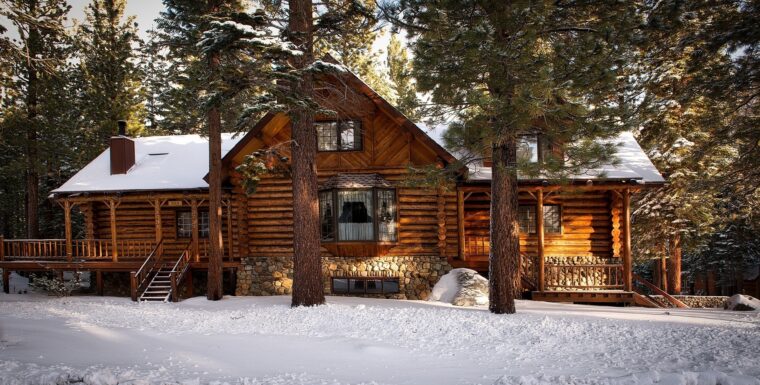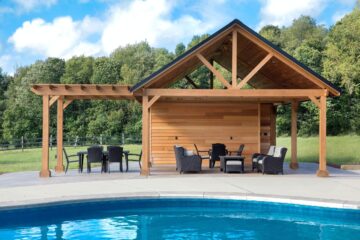
Log homes provide unique beauty and charm, unlike any other type of home. To keep log homes looking beautiful, maintenance is essential. Proper maintenance on a log home can be difficult if you don’t know what to look for or how to properly take care of it.
In this article, we will explore the common issues associated with log homes and nine considerations that homeowners should understand when it comes to maintenance.
The Benefits and Appeal of Log Homes

Log homes are becoming increasingly popular for those looking to build a home that is both environmentally friendly and aesthetically appealing. Log homes can be constructed using renewable materials, such as locally harvested wood, which has the benefit of reducing our reliance on non-renewable resources. Furthermore, log homes offer the opportunity to be highly customized with various wood stains and treatments that can give each cabin its unique character.
Additionally, they provide a warm and inviting atmosphere thanks to their natural charm and rustic appeal. Last but not least, log homes are extremely durable, which makes them a great investment for those looking for an eco-friendly and beautiful home solution.
Common Issues with Log Homes

Owning a log home often comes with a few common problems that need to be addressed to maintain the structure. Some of these issues include rot, insect infestations and weathering due to extreme temperatures.
Rot is caused by moisture buildup inside the logs which can lead to damage and decay over time. Insect infestation occurs when wood-boring insects make their way into the log walls or other areas of the home.
Weathering can result from exposure to rain, snow and extreme temperatures, which can cause the logs to crack or shift. Regular maintenance and inspection of your log home can help minimize the risk of these issues occurring.
9 Considerations for Proper Log Home Maintenance
1. Inspect the Exterior Regularly
Inspecting the logs and other areas of the home regularly can help you spot any potential issues before they become a big problem. This also gives you the chance to address any minor repair work that may be needed to keep your log home looking great. By ensuring that all areas of the home are in working order, you can extend its life while avoiding costly repairs down the road.
2. Keep the Logs Clean
Routinely cleaning the logs helps protect them from rot, insect infestations and extreme temperatures. A pressure washer or other mild cleaning solution can be used to remove dirt and grime buildup.
This will keep moisture away from the inside of the logs which could potentially lead to deterioration. Plus, it allows you to locate any cracks or weaknesses in need of repair.
3. Apply and Maintain Stain and Protective Finish

Staining and sealing the logs of your log home is a crucial part of its maintenance. Applying stain to the logs on a regular basis will not only maintain their attractive aesthetic but also safeguard them from harsh environmental conditions.
Applying a stain such as ZAR® Platinum PRO Translucent Exterior Urethane Finish to the surface of the logs can further protect them from damage, as it creates a barrier that prevents moisture from seeping into the wood.
Additional protection is available in the form of a sealer. ZAR Platinum Pro Clear Coat is the perfect solution for log and timber-structured homes that need superior protection and a long-lasting finish. Formulated with aliphatic urethane, this clear coat offers an unbeatable level of defense against everyday wear and tear in routine maintenance applications. This can significantly extend the life of your log home while reducing costly repairs in the future.
4. Caulking and Chinking
A log home industry typically makes use of two forms of caulking — acrylic and urethane-based. Caulk should be applied between each layer of logs horizontally.
Chinking, on the other hand, is applied vertically at the edges of the logs. Traditionally, the material used to insulate between log cabins was whatever people could find — clay mixed with straw or even mortar and cement.
Unfortunately, these materials proved insufficient in preventing moisture from entering, as they would eventually pull away from the logs once hardened. Thankfully, contemporary chinking products work excellently like caulk does and will safeguard your home against wind and rain for years to come.
Not only is modern chinking soft, pliable and able to last many years after installation, but it also offers unbeatable adhesion, flexibility and durability. This product is the perfect solution to keep your home well-protected, and it’s ideal for both indoor and outdoor applications.
5. Roof and Gutter Maintenance
Regularly cleaning out your gutters and repairing any cracked or broken roof tiles will prevent water from pooling and dripping down the exterior walls, which can cause significant damage over time.
6. Keep Landscaping Cut Back
Planting too close to the house can lead to bushes and trees growing against the walls, which can cause damage over time. Additionally, large amounts of foliage around a log home can hold in moisture and lead to rot or mold buildup. Keeping landscaping away from the house will help keep it safe from potential damage and will help extend the life of the logs.
7. Inspect the Foundation
Regular inspections of the foundation can help identify any problems before they become too severe and save time and money on repairs. Cracks or weak spots in the foundation can cause serious issues if not fixed quickly, so checking for these regularly will help protect your home from potential disasters.
8. Proper HVAC Maintenance and Care on the Interior
Proper HVAC maintenance and care are essential for keeping your log home comfortable and secure. Regularly changing filters and checking for ventilation problems can help prevent more serious issues from occurring in the future.
Excess moisture inside a poorly ventilated log home can lead to a variety of problems. It can promote the growth of mold and mildew, which can cause both structural damage and health hazards.
It can also cause rot, decay and warping of the logs, which can make the home dangerous or even unlivable. Poor ventilation also reduces energy efficiency and makes it more expensive to keep your log home at comfortable temperatures throughout the year.
9. Pest Control
Pests such as termites and carpenter ants can cause serious damage to the structure of your log home if left unchecked, leading to costly repairs. Regularly inspecting and treating any areas where pests may have entered should be a priority for any log homeowner. It can help protect your investment in the long run and ensure that your log home remains safe and secure for many years to come.
Find the Best Stains and Protective Finishes for Your Log Home with ZAR

ZAR has a full line of stains and sealers that are specifically designed for the maintenance of log homes. We offer a wide variety of colors to choose from so you can get the exact look you want and the protection your log home needs. Our products are durable and provide years of lasting protection against fading, weathering and sun damage.
ZAR is the perfect choice for making sure your log home looks great and stays in top condition all year round. Contact us today to locate a retail store near you!



